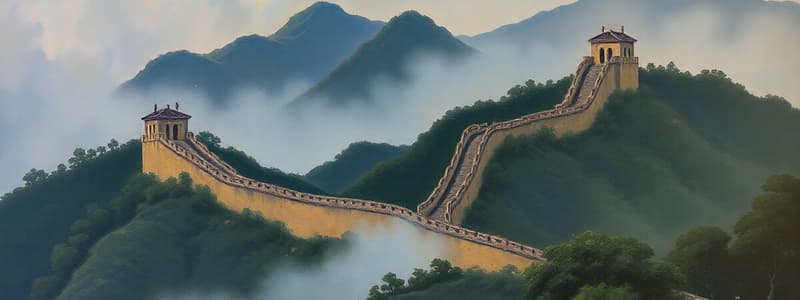Podcast
Questions and Answers
Which of the following best describes the primary initial motivation behind the invention of gunpowder in ancient China?
Which of the following best describes the primary initial motivation behind the invention of gunpowder in ancient China?
- Developing advanced weaponry for military dominance.
- Improving mining operations through controlled explosions.
- Creating visually stunning fireworks for celebrations.
- Searching for an elixir to achieve immortality. (correct)
What was the significance of the Great Wall of China in demonstrating Chinese technological capabilities?
What was the significance of the Great Wall of China in demonstrating Chinese technological capabilities?
- It showcased the ability to create intricate silk garments on a massive scale.
- It highlighted the nation's bronze metalworking expertise.
- It demonstrated advancements in agricultural irrigation techniques.
- It exemplified large-scale engineering and construction using varied materials. (correct)
How did the development of silk production in ancient China affect global interactions?
How did the development of silk production in ancient China affect global interactions?
- It spurred rapid advancements in European shipbuilding technology.
- It facilitated cultural, economic, and scientific exchanges through trade. (correct)
- It led to widespread adoption of Chinese religious practices in foreign lands.
- It resulted in the standardization of agricultural practices across Asia.
How did the innovation of papermaking influence the development of Chinese arts and culture?
How did the innovation of papermaking influence the development of Chinese arts and culture?
Why is Shennong, also known as the Divine Farmer, a significant figure in Chinese history?
Why is Shennong, also known as the Divine Farmer, a significant figure in Chinese history?
During which dynasty did bronze production become a significant and widespread practice in China?
During which dynasty did bronze production become a significant and widespread practice in China?
What raw materials were primarily used by Cai Lun in the invention of paper?
What raw materials were primarily used by Cai Lun in the invention of paper?
Besides writing, what other purposes did coarser and stronger paper serve in ancient China?
Besides writing, what other purposes did coarser and stronger paper serve in ancient China?
Flashcards
Chinese Civilization
Chinese Civilization
Oldest civilization in Asia, known as the "Middle Kingdom."
Silk Production
Silk Production
The Chinese developed the technology to harvest silk and process it for paper and clothing.
Shennong
Shennong
Considered the Father of Agriculture, honored with the discovery of tea.
Great Wall of China
Great Wall of China
Signup and view all the flashcards
Gunpowder
Gunpowder
Signup and view all the flashcards
Bronze production
Bronze production
Signup and view all the flashcards
Paper making
Paper making
Signup and view all the flashcards
Toilet paper
Toilet paper
Signup and view all the flashcards
Study Notes
- The objective is to explain how science and technology affect society and the environment and vice versa.
- It is important to identify inventions and discoveries that have changed the world throughout history.
- One goal is to discuss scientific and technological developments in the Philippines.
Chinese Civilization
- China is the oldest civilization in Asia.
- China is known as the middle kingdom.
Silk
- The Chinese developed the technology to harvest silk and process it into paper and clothing.
- Silk production facilitated trade, leading to cultural, economic, and scientific exchange.
- Shennong, the Divine Farmer and Chinese Father of Agriculture, is honored for discovering tea.
- Tea production developed after an unknown Chinese inventor created tea-leaf-shredding machine.
Great Wall of China
- The Great Wall of China is the largest and most extensive infrastructure built by the nation of China.
- The Wall was constructed to keep out foreign invaders and control China's borders.
- Made of stone, brick, wood, and earth, the Wall showcased Chinese engineering technology.
Gunpowder
- Gunpowder was originally developed to achieve immortality.
- Mixing charcoal, sulfur, and potassium nitrate inadvertently created black powder, which generates heat and gas instantly.
- Gunpowder is also used in fireworks.
Bronze Production
- Bronze production occurred under the Shang Dynasty (1766–1122 BCE).
- Combining copper, tin, lead, and zinc led to experimental progress until the ideal mix was achieved.
Paper Making
- Paper making is credited to Cai Lun.
- Vegetable fibers from hemp rope ends, cloth rags, and old fishing nets were used.
- Coarser paper served for clothing, lacquer-ware, wall decor, and military armor.
- The use of toilet paper comes from China, dating back to the 6th century.
- Paper led to calligraphy, watercolor painting, and block printing.
Studying That Suits You
Use AI to generate personalized quizzes and flashcards to suit your learning preferences.
Related Documents
Description
Explore the impact of science and technology on Chinese society and the environment. Discover key Chinese inventions like silk production and their influence on global trade. Learn about the Great Wall of China and its historical significance.




